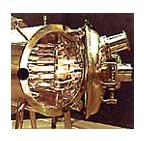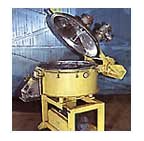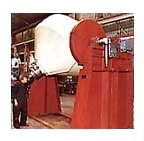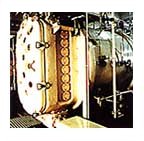Vacuum Dryers
The Vacuum Dryers are used where materials to be dried are heat sensitive or liable to oxidation. Solvents can readily be recovered by means of a simple condenser system. Toxic materials can be processed without operator contact. These dryers can be supplied complete with heating system, vacuum pump, solvent condensor and service piping.
There are several kinds of Vacuum Dryers available. These are:
- Vacuum Shelf Dryers
- Agitated Pan Dryers
- Double Cone Dryers
- Vacuum Band Dryers
Vacuum Shelf Dryers
This is the simplest type of unit with the wet material carried on trays which are placed onto heating platens within the vacuum chamber. High efficiency heating platens in direct contact with the total tray surface ensure maximum heat transfer and even drying. Circular or rectangular units can be supplied and these are ideal for small to moderate levels of production. Sizes range from 1.25m² up to 19m² tray area.
Agitated Pan Dryers
This is the most versatile of the vacuum dryers capable of taking feed materials in either liquid, paste or powder form. The cylindrical vessel is jacketed for steam, hot water or oil and is fitted with an internal agitator to facilitate drying and discharge of the dry powder. These units can be used atmospherically as well as under vacuum and are available with a feed capacity from 75 to 2135 litres.
Double Cone Dryers
The material to be dried is tumbled in a slow rotating vessel of double cone construction which is jacketed for steam, hot water or oil heating. As the dryer rotates the rapid and thorough intermixing of the entire batch brings every particle in contact with the heated metal. These dryers are suitable for damp powders or granules handling batch charges from 28 to 10,500 litres.
Vacuum Band Dryers
Vacuum band dryers provide a continuous means of handling heat sensitive materials which can be fed as a viscous liquid or paste. The band dryer comprises a vacuum chamber housing a number of conveyor bands which pass over platens heated by steam or hot water. These units are supplied with a range of capacities using single to ten band configurations. Typical applications; soluble beverages, extracts, enzymes and pharmaceutical products.



